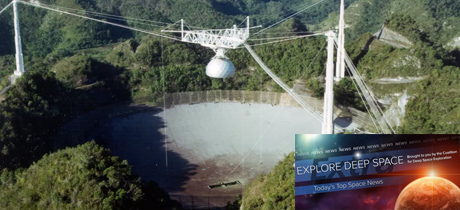In Today’s Deep Space Extra… The National Science Foundation (NSF) plans to decommission the Arecibo radio telescope in Puerto Rico. The Mars 2020 Perseverance rover team has collected audio of the spacecraft’s hurtles through deep space.
Human Space Exploration
Air leakage from Russian module of ISS remains
TASS of Russia (11/19): Efforts to characterize a small crack in the Zvezda module of the International Space Station’s (ISS) Russian segment continue. On Tuesday, the Station’s cosmonauts placed a new patch on the “scratch” that is believed to be the source of a small loss of air first noticed in September 2019. During a spacewalk on Wednesday, cosmonauts Sergey Ryzhikov and Sergey Kud-Sverchkov imaged the outside of the module corresponding to the suspected leak source but noticed no external damage. (Editor’s Note: TASS is an official news outlet of the Russian government.)
Space Science
Losing Arecibo Observatory would create a hole that can’t be filled, scientists say
Space.com (11/19): The National Science Foundation (NSF) announced it will decommission the Arecibo radio telescope because of the risks involved in repairing two broken cables that support a 900-ton platform that hangs over the observatory’s main dish. Some scientists are expressing reservations about the decision to dismantle the telescope. Among them is Jill Tarter, a scientist famous for her work on the search for extraterrestrial intelligence (SETI) and the inspiration for the main character in the movie “Contact.”
Hear the audio NASA’s Perseverance rover recorded on its way to Mars
Cnet (11/19): A microphone aboard NASA’s Perseverance rover has recorded the sounds of the spacecraft as it travels through interplanetary space. The mission’s team collected the audio during an in-flight checkout of the microphone system that will record the rover’s landing moments. Perseverance will be landing at Mars’ Jezero Crater in February 2021.
Scientists discover outer space isn’t pitch-black after all
National Public Radio (11/18): NASA’s New Horizons mission, known for achieving the first-ever close flyby of Pluto during the summer of 2015, is providing evidence for light coming from the seemingly dark realm between stars across the universe. The sources of a faint luminescence are largely a mystery.
India’s Shukrayaan orbiter to study Venus for over four years, launches in 2024
SpaceNews.com (11/19): India’s space agency aims to launch its Venus orbiter Shukrayaan in late 2024. Shukrayaan is India’s first mission to Venus and will study the planet for more than four years. The mission will map Venus’ surface and subsurface while studying the planet’s atmospheric chemistry and interaction with the solar wind.
Other News
Maxar taps MDA for robotic satellite servicing technologies
Coalition Member in the News – Maxar
SpaceNews.com (11/17): MDA, noted for developing the robotic arms on NASA’s space shuttle and the International Space Station (ISS), has been tapped by previous owner Maxar for hardware and software supporting Space Infrastructure Dexterous Robot (SPIDER) technologies for on-orbit servicing, assembly, and manufacturing operations. A market for on-orbit satellite servicing is on the rise.
Rocket Lab successfully brings its rocket back to Earth underneath a parachute
The Verge (11/19): Launching from New Zealand on Thursday, small satellite launch services provider Rocket Lab demonstrated the early steps in a strategy to recover the company’s Electron rocket for reuse. Thursday’s launch featured the rocket booster’s descent into the ocean. In the future, Rocket Lab plans to retrieve the rocket booster as it descends to Earth under parachutes with a helicopter grab.
Air Force reveals candidate locations for U.S. Space Command headquarters
SpaceNews.com (11/19): Candidate sites provided by the U.S. Air Force and announced on Friday to serve as the headquarters for the U.S. Space Command are Peterson Air Force Base, Colorado; Kirtland Air Force Base, New Mexico; Patrick Air Force Base, Florida; Redstone Army Airfield, Alabama; Joint Base San Antonio, Texas; and Offutt Air Force Base, Nebraska. A final decision is anticipated for early 2021. It will take about six years to build the headquarters facilities.

